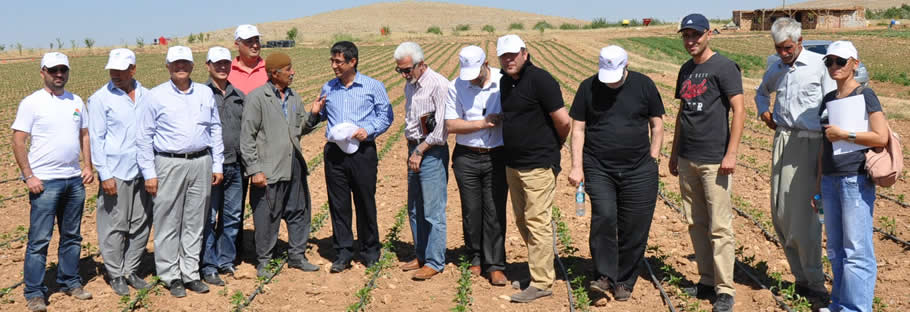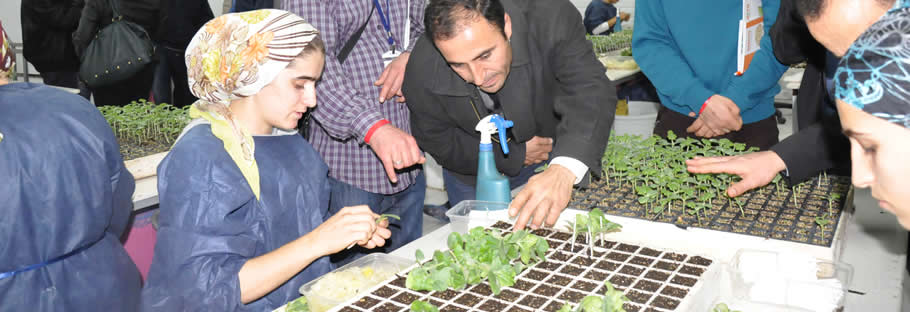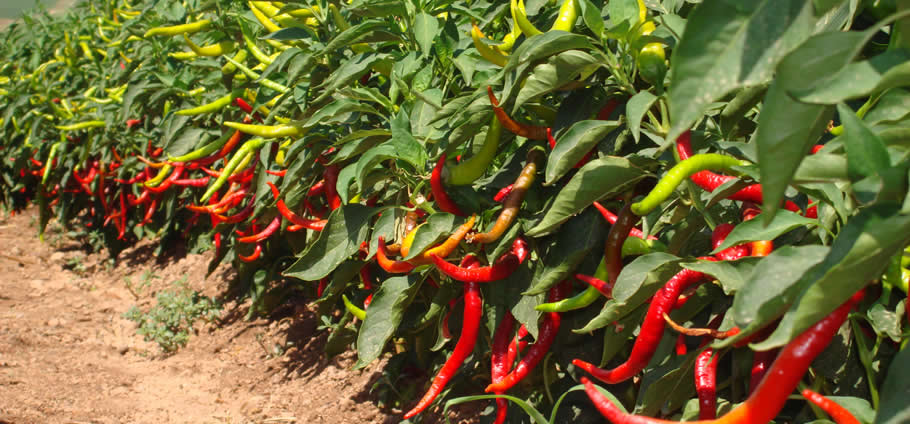GAP Regional Development Administration (GAP-RDA) implemented by GAP Agricultural Training and Extension Project (GAP-TEYAP) aims a sustainable model that targets to be given an effective training and extension to ensure the optimal use of natural resources in the agricultural sector which is an important component in ensuring regional development.
Objectives of the Project
Objectives of the project are to contribute to increasing the efficiency of agricultural training and extension services in the areas of GAP which were opened or will be open for irrigation; as well as contributing towards increasing the capacity of institutions and organizations, especially farmer’s organizations that serve in this regard.

The project has focused on two main issues. The first is the need for improving the efficiency of agricultural training and extension services meanwhile the other is to determine the sustainable agriculture extension and advisory model/models which function in accordance to the principle of self-aid.
By taking into consideration the budget and duration of the project, it is not foreseen to completely eradicate the deficiency of services for agricultural extension and consultancy with the project in question. The project has undertaken the task of demonstrating how to settle such identified deficiencies with model/models to be developed.
The developed model was executed as “Farmers’ Organizations Centred Pluralistic Extension Model Implementation Plan” within our Administration, carried out in coordination with relevant institutions and organizations under the title of the GAP Agricultural Training and Extension Project (GAP TEYAP) on January 1st, 2014.
Duration of the Project and Field of Study
GAP TEYAP was implemented de facto on April 15, 2011, and the standard completion date of the project was December 31, 2012; however this duration was extended to be December 31, 2013 and was completed on this date.
The most important output of the project, a sustainable extension model, the “Farmers’ Organizations Centred Pluralistic Extension Model” will be implemented for 5 (five) years in the provinces in the GAP region, primarily in areas that were or will be irrigated, such as Adıyaman, Batman, Diyarbakır, Gaziantep, Kilis, Mardin, Siirt, Şanlıurfa and Şırnak.
Target Group of the Project
With GAP TEYAP,
Farmers in the working area of the project have been the ultimate target audience of the project. However, a project to work one-to-one with farmers engaged in agriculture in these areas is not possible. Therefore 5,000 farsighted farmers having the ability to make decisions will form the first target group, meanwhile 15,000 farmers in the vicinity of our farmers will form secondary target group, and 60,000 farmers around them will form a tertiary target group. Thus, a total of 80,000 farmers are expected to be reached directly.
Public extension personnel and agriculture consultants that provide agricultural extension and consultancy services, 500 people consisting of experts or consultants work with farmer’s organizations and free market were included in the primary target group.

The activities carried out on December 1, 2013;
(The planned 500 technical staff, 5,000 farmers on various issues in response to the training activities, 1,676 activities were carried out, through these activities, 11,206 farmers and 2,181 farmer/NGO/public freelancer technical staff have direct access and approximately 140,000 farmers have been reached indirectly to increase capacity.)
Target group developed in GAP TEYAP “Farmers’ Organizations centred Pluralistic Extension Model”,
Within the scope of the 5-year implementation plan of the model, at least 40 of the 615 existing farmers’ organizations and 240 technical staff are expected to work as an extension element. 40 farmers’ organizations to enter the system and 240 extension personnel to operate will form the primary target group.
Also, within the scope of the model, the Ministry of Agriculture extension staff and farmers’ organizations took place outside the primary group, and approximately 1,000 technical personnel working in extension in the private sector will be the secondary target group of the project. As a result of full implementation of the model, about 15,000 farmers who will be directly receive effective extension services, including the areas that will be opened for irrigation, 40,000 farmers will be the beneficiaries of the project directly and indirectly.
In addition, within the scope of creating organizational awareness of agricultural issues in the region and activities to be done in terms of their referral to contribute to agricultural development, farmers operating in 9 provinces will also form another target group of the project.
Activities of the Project
GAP TEYAP
The project has implemented the following activities directed to four main components.
Component 1. Improving the capacity of relevant institutions and organizations that provide these services in agricultural extension and consultancy services.
Component 2. Increasing the capacity of farmers and farmer organizations.
Component 3. Ensuring coordination between organizations and institutions in terms of agricultural extension and consultancy services and raising awareness.
Component 4. The development of a sustainable agricultural training and extension model/models which operate with the principle self-aid in the region of GAP.
Needed in the GAP region, acting under a sustainable and effective agricultural training and development of extension model, the implementation of the following activities is planned.
- Creating Agricultural Extension Model Group
- Agricultural Extension Models Training
- Model Building Workshops
- Model Building Meetings
GAP TEYAP “Farmers’ Organizations Centred Pluralistic Extension Model” activities,
IMPLEMENTATION EFFORTS FOR THE EXTENSION MODEL
- PREPARATION
1.1. Creation of Model Implementation Units (MUB) and Boards
1.2. Identification of Farmers’ Organizations and Signing of Protocols
1.3. Studies on Obtaining Consultancy Authorisation Certificate for the Farmers’ Organisations
1.4. Identification of Infrastructure and Equipment Requirements of Farmers’ Organisations
1.5. Farmers’ Organization Inventory Study
1.6. Preparation of Training Requirements Analysis Report
- IMPLEMENTATION
2.1. Consultant Basic Trainings
2.2. Clearing Detected Lack of Infrastructure and Equipment in Farmers’ Organizations
2.3. Model Introduction
2.4. Implementation of the Education and Extension and Research Programme According to the Needs
2.4.1. Training for the Consultants of Farmers’ Organizations
2.4.2. Demand-Based Training for the Regional Consultants and the Extension Agents
2.4.3. Training, Publication and Information Study for the Farmers’ Organization Members
2.4.4. Demand-Based Education to other farmers, Extension and Information Studies
2.4.5. Strengthening Works for the Ties Between Research, Publisher and Farmer
2.5. Printed and Visual Material Preparation
- SUSTAINABILITY AND DISSEMINATION
3.1. Studies towards strengthening farmers’ organization in terms of administrative, technical and financial matters
3.2. Monitoring and evaluation of the project implementation
3.3. Studies relating to the transfer of the farmers’ organizations of the implementation model
B- WORKS TO BE DONE IN AREAS OPENED AND TO-BE-OPENED FOR IRRIGATION
- Identifying areas to be opened for irrigation
- Making Analysis of Needs
- Preparation and Submission of Water Readiness Action Plans
- Implementation of Activities to do within the Scope of Water Readiness Action Plans
- Studies for the inclusion of agricultural education extension activities of water user organizations,
- Efforts to establish new water user organizations to be included in agricultural education extension activities
- Monitoring and Evaluation
ORGANIZATION AND GROUPING WORKS
- Actions about organizing
1.1. Studies to create awareness in organising
1.2. Preparation of an action plan for organising
1.3. Efforts to promote the creation of new farmers’ organizations
- Actions about grouping
COORDINATION AND AWARENESS ACTIVITIES
- Central Advisory Board (MEDAK) Meeting
- Regional Advisory Council (BODAK) Meeting
- Provincial Coordination Unit (İKOB) Meeting
- Demand-Based Meeting, Panel, Seminars and Workshops
- Interviews with Training Centers for Implementation
MONITORING AND EVALUATION
- Term Meeting and Interim Reports
- Annual Progress Reports
- Evaluation


